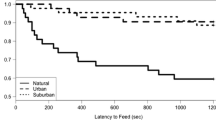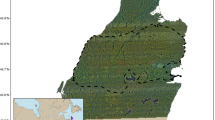Abstract
We examined the foraging behavior of woodland caribou (Rangifer tarandus caribou) relative to the spatial and temporal heterogeneity of their environment. We assessed (1) whether caribou altered their behavior over time while making trade-offs between forage abundance and accessibility; and (2) whether foraging decisions were consistent across spatial scales (i.e., as scale increased, similar decision criteria were used at each scale). We discuss whether caribou adjusted their behavior to take advantage of changing forage availability through time and space. At the scale of the feeding site (as revealed by discriminant function analyses), caribou in both forested and alpine (above tree-line) environments selected sites where the biomass of particular lichen species was greatest and snow the least deep. Caribou did not select those species with the highest nutritional value (i.e., digestible protein and energy) in either area. Where snow depth, density, and hardness limited access to terrestrial lichens in the forest, caribou foraged instead at those trees with the greatest amount of arboreal lichen. Selection of lichen species and the influence of snow differed across time, indicating that in this system the abundance or accessibility of forage temporally influenced foraging behavior. A path analysis of forest data and multiple regression analysis of alpine data were used to test the hypothesis that variables important at the scale of the feeding site explained foraging effort at the scale of the patch. For forest patches, our hypothesized model reliably explained foraging effort, but not all variables that were statistically important at the scale of the feeding site were significant predictors at the scale of the patch. For alpine patches, our hypothesized model did not explain a statistically significant portion of the variation in the number of feeding sites within the patch, and none of the individual variables from the feeding site remained statistically significant at the patch scale. The incongruity between those variables important at the scale of the feeding site and those important at the patch showed that spatial scale affects the foraging decisions of woodland caribou. At the scale of the landscape, there was a trade-off between forage abundance and accessibility. Relative to the alpine environment, caribou in the forest foraged at feeding sites and patches with greater amounts of less variably distributed lichen, but deeper less variable snow depths. Considering the behavioral plasticity of woodland caribou, there may be no distinct advantage to foraging in one landscape over the other.
Similar content being viewed by others
Author information
Authors and Affiliations
Additional information
Electronic Publication
Rights and permissions
About this article
Cite this article
Johnson, C.J., Parker, K.L. & Heard, D.C. Foraging across a variable landscape: behavioral decisions made by woodland caribou at multiple spatial scales. Oecologia 127, 590–602 (2001). https://doi.org/10.1007/s004420000573
Received:
Accepted:
Published:
Issue Date:
DOI: https://doi.org/10.1007/s004420000573




